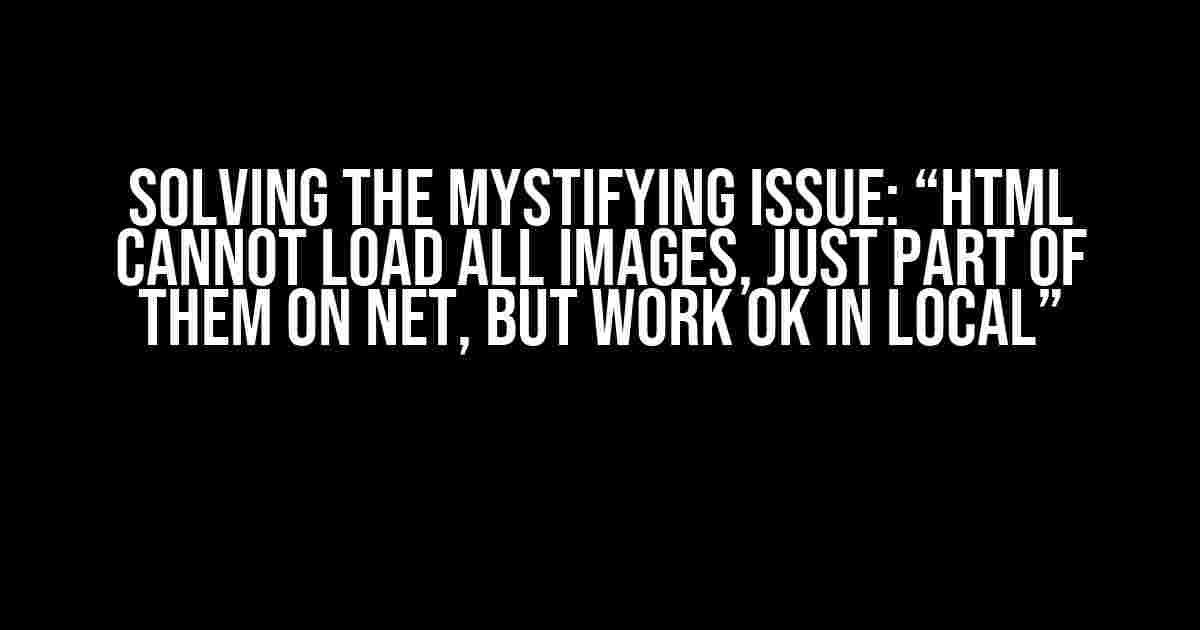Have you ever encountered the frustrating problem where your HTML code refuses to load all the images online, but works seamlessly when run locally? You’re not alone! This phenomenon has perplexed many developers, leaving them scratching their heads and questioning their coding skills. Fear not, dear reader, for we’re about to dive into the depths of this enigma and emerge with a comprehensive solution.
Understanding the Problem
Before we tackle the solution, let’s first understand what’s happening behind the scenes. When you upload your HTML file to a server, it’s no longer running locally on your machine. This change in environment can cause unexpected behavior, especially when it comes to loading images.
Reasons for Image Loading Issues
- File Path Inconsistencies: Local file paths may not translate correctly to online environments, leading to image loading failures.
- Server Configuration: Server settings can restrict or modify file access, causing images to not load properly.
- File Permissions: Incorrect file permissions can prevent images from being accessed or loaded by the browser.
- Browser Security Restrictions: Some browsers have strict security policies that block images from loading due to cross-origin resource sharing (CORS) issues.
- Image Format and Compression: Using incorrect or unsupported image formats, or compression methods, can cause loading issues.
Diagnosing the Issue
To identify the root cause of the problem, follow these steps:
- Check the Browser Console: Open the browser console and inspect the network requests to see which images are failing to load. Look for error messages, such as 404 (Not Found) or 403 (Forbidden).
- Verify File Paths and Permissions: Ensure that file paths are correct and that the necessary permissions are set for the images.
- Test Image URLs: Directly access the image URLs in a new browser tab to see if they load properly.
- Check Server Logs: Review server logs to identify any errors or issues related to image loading.
Solving the Issue
Now that we’ve identified the potential causes and diagnosed the problem, let’s implement the solutions:
Using Relative URLs
Instead of using absolute URLs, switch to relative URLs for your images. This will ensure that the browser looks for the images in the correct location, regardless of the environment.
<img src="images/logo.png" alt="Logo">Replace:
<img src="C:/Users/Username/images/logo.png" alt="Logo">Setting Correct File Permissions
Ensure that the image files have the necessary permissions to be accessed by the server and browser. You can do this by setting the file permissions to 755 or 644, depending on your server configuration.
| Permission | Description |
|---|---|
| 755 | Rwxr-x (Owner has read, write, and execute permissions; Group has read and execute permissions; Others have read and execute permissions) |
| 644 | Rw-r– (Owner has read and write permissions; Group has read permission; Others have read permission) |
Configuring Server Settings
Check your server settings to ensure that they are not restricting or modifying file access. For example, you may need to update your `.htaccess` file to allow image loading.
<IfModule mod_rewrite.c>
RewriteEngine On
RewriteCond %{REQUEST_FILENAME} !-f
RewriteRule ^(.*)$ index.html [QSA,L]
</IfModule>Using CORS-Friendly Image Formats
Some image formats, like WebP, may not be supported by all browsers. Ensure that you’re using widely supported formats like JPEG, PNG, or GIF. You can also consider using a CDN or image optimization services that support CORS.
Optimizing Image Compression
Optimize your image compression to reduce file size and improve loading times. You can use tools like TinyPNG or ImageOptim to compress your images.
Conclusion
The mystery of HTML not loading all images online, but working locally, is a common issue that can be resolved with a combination of technical expertise and attention to detail. By following the steps outlined in this article, you’ll be able to identify and solve the problem, ensuring that your images load seamlessly in both local and online environments. Remember to stay vigilant and troubleshoot thoroughly to avoid any future issues.
Final Checklist
- Use relative URLs for images
- Set correct file permissions (755 or 644)
- Configure server settings to allow image loading
- Use CORS-friendly image formats (JPEG, PNG, GIF)
- Optimize image compression for faster loading times
By following this comprehensive guide, you’ll be well on your way to resolving the “HTML cannot load all images, just part of them on net, but work OK in local” issue. Happy coding!
Here are 5 Questions and Answers about “html cannot load all images just part of them on net, but work ok in local” using a creative voice and tone:
Frequently Asked Question
Are you having trouble loading images on your HTML page? Don’t worry, we’ve got you covered!
Why do some images load but not all on my HTML page when uploaded online, but they work perfectly fine locally?
This is a classic issue! It’s likely due to file permissions or incorrect file paths. When you upload your files online, the file paths might change, causing the images to break. Double-check your file paths, and make sure all files are uploaded correctly.
Is it possible that my hosting provider is blocking or restricting image uploads?
It’s possible! Some hosting providers have restrictions on file types or sizes. Check your hosting provider’s documentation or contact their support team to see if there are any limitations on image uploads.
Could it be a caching issue? Maybe my browser is playing tricks on me!
You’re on the right track! Caching issues can cause problems with image loading. Try clearing your browser cache or using a private browsing mode to see if the issue persists. If not, it might be a caching issue on the server-side, and you’ll need to contact your hosting provider for assistance.
I’m using relative URLs for my images. Could that be the problem?
Relative URLs can be tricky! When you upload your files online, the relative URLs might not work as expected. Try using absolute URLs or defining a base URL in your HTML document to see if that resolves the issue.
I’ve checked everything, and I’m still having trouble. What’s my next step?
Don’t worry, we’re here to help! If you’ve checked all the above possibilities and still can’t load all your images, try debugging your HTML code using the developer tools in your browser or an HTML validator. If that doesn’t work, feel free to ask for more help or seek assistance from a web development expert.




